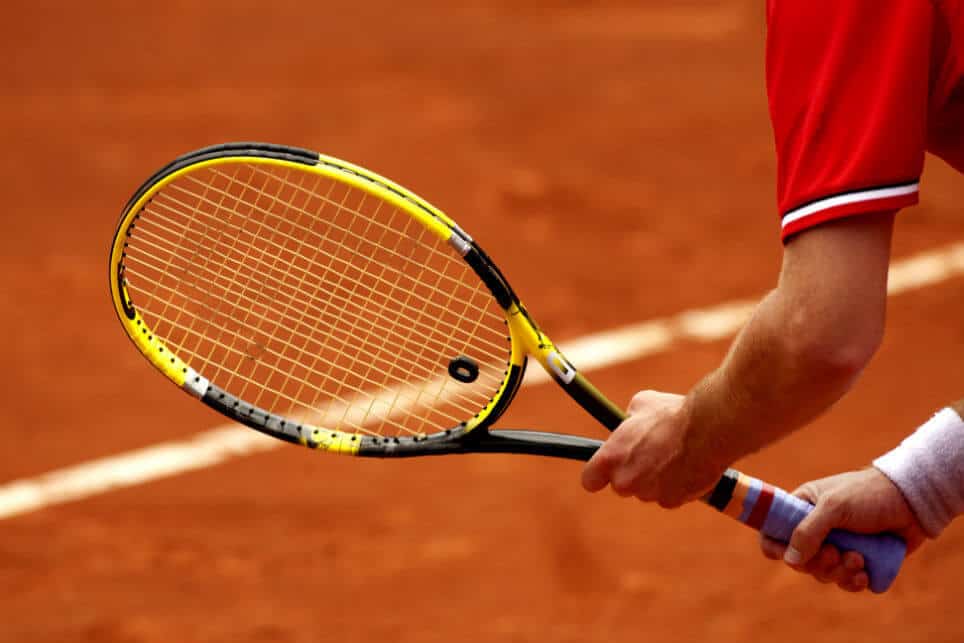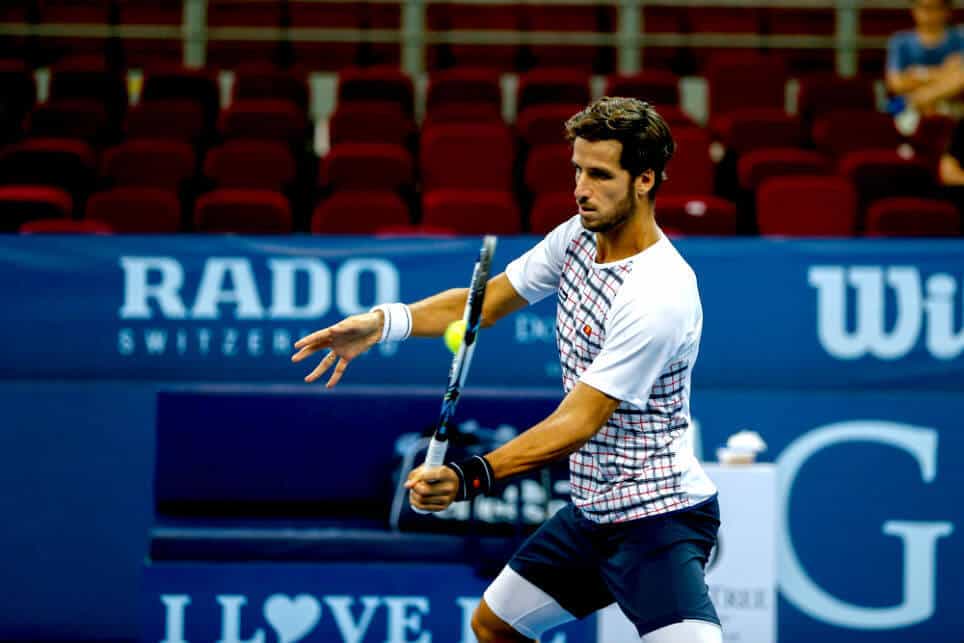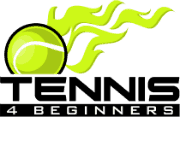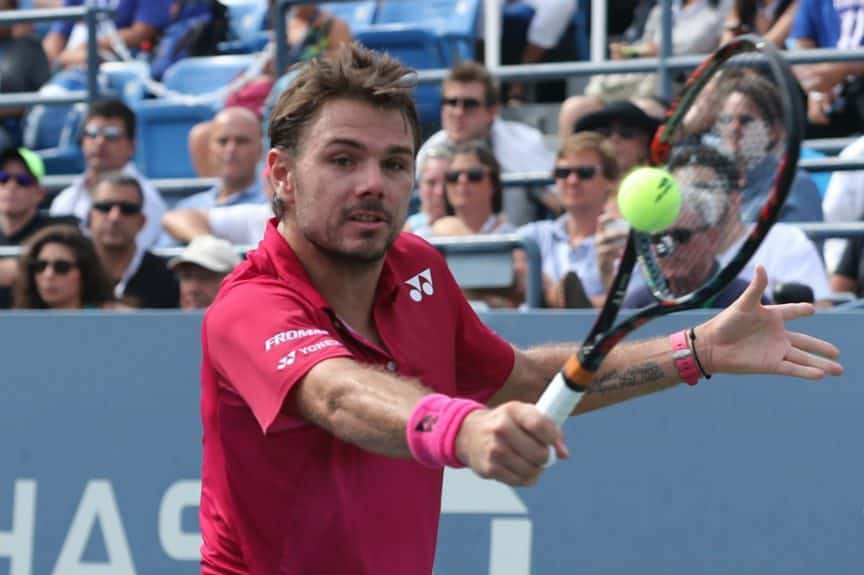An important part of your shot arsenal, the volley can help add a new dimension to your game. The volley allows you to attack after serves or approach the net following a deep groundstroke shot to your opponent. This makes it possible for you to finish off a point more quickly.
The volley differs from other shots in that it does not involve a full swing. You should aim to swing at the shot as little as possible. A good ready position with the racket head held high and supported by the non-hitting hand is important when starting the volley. Keep the racket head high and in front of you as you turn towards the oncoming ball. Block (or punch) the ball as it comes to you, using your weight to step forward. Finish with a slight use of the wrist for added spin and placement.
Used as an aggressive shot in tennis, the volley is ideally played up close to the net. Sometimes circumstances require volley shots be taken further back. Whether a volley is taken close to the net or further back affects the range of motion to some extent.
The volley is used extensively in doubles tennis. Oftentimes, back and forth volley shots occur between doubles opponents. Sometimes with both teammates up at the net simultaneously.
1. Start with a Continental Grip
The continental grip is usually the best grip to use for volleys. It allows you to easily switch between a forehand and backhand shot without having to adjust the grip. See the article on how to grip a tennis racket for more information on this and other grips used in the game.
One of the advantages of the continental grip is that it allows you to set up the racket immediately in the ready position. Additionally, the face of the racket will be naturally positioned towards the oncoming ball. This allows you to react quickly to oncoming shots.
If the continental grip feels uncomfortable, particularly if you are a beginner, you can use an eastern grip on the forehand. Most likely on the backhand, you will want to use the continental regardless.
Another instance where you may want to use the eastern grip is on high shots to your forehand side. It’s more difficult to execute a volley using the continental grip when the oncoming ball is high.
Switching grips should not be an issue as long as you set up in a good ready position. Once you know which side the ball is coming from, rotate the racket slightly with your non-hitting hand to accommodate the grip you want to use.

2. Good Starting Ready Position
Starting out in a good ready position is critical to proper execution. While up at the net, lean forward slightly with your knees bent and feet spread apart at least shoulder width. This will provide you with a lower center of gravity, allowing you to more quickly push off with your feet in either direction.
When setting up for a volley shot, you should make sure your eyes are locked on the ball. Keep your eyes on the ball from the moment your opponent makes contact all the way through when you make contact with the ball.
Hold the racket in front of you with the head of the racket higher than the handle. This is used in other shots in tennis but is particularly critical during volleys for proper execution. Your non-hitting hand should be supporting your racket either at the head beam or the throat of the racket.
3. Position Racket in Front
Unlike groundstrokes where you turn your body and bring the racket back, for volleys you want to maintain the racket in front and turn your body only slightly as you position the racket for either a forehand or backhand volley.
You want to keep the racket in front of you during the entire motion. As you determine which side the ball is coming on, immediately turn your shoulder in that direction. Keeping the racket in front, position the head higher than the handle.
Low shot volleys, which can occur when you get caught near the service line, require an adjustment to the racket head positioning. During contact, the racket head would need to drop lower through contact, but the racket should still be positioned in front of you.
Sometimes in these situations, you may not be able to strike the ball before it bounces. In this case, you will need to hit a half-volley with the racket low and just in front of your feet.
4. Use Your Bodyweight for Power
One thing to keep in mind is that a volley does not need to be hit hard to be effective. This is one of the reasons you want to avoid swinging the racket. A crisp shot placed well out of reach of your opponent should be your goal.
Most of the power on the shot should come from your body weight. Since you will be limiting your motion of the swing, you need to use your body weight to generate power.
For this reason, the starting position with weight shifted forward is critical. As you rotate to make contact with the ball on either side, your weight will naturally shift forward in that direction and through the point of contact.

5. Step into Your Volleys
As your body is leaning forward during contact with the ball, you will naturally want to step through on the shot. This should happen simultaneously to when you block the shot – also referred to by some as “punching” the volley.
In other words, you step and block/punch at the same time. On forehand volleys, the leg on the opposite side of your racket steps forward, while on backhand volleys the leg on the same side of the racket steps forward.
For a right-handed player, the left leg steps forward during a forehand volley while on a backhand volley the right leg steps forward. Landing and recovery following the step-through are also critical.
6. Landing and Recovery
It’s important after you step forward that you immediately bounce back from your feet and resume the ready position. Since playing up at the net reduces the court distance between you and your opponent, you will need to be quick in recovering.
Following recovery, you want to quickly reset into the ready position facing the net with the racket held in front of you. This will allow you to quickly react to subsequent shots taken at you while you are positioned at the net.
In case your opponent decides to lob the ball over you, the ready position will allow you to quickly register the oncoming lob and react by turning your body and running back towards the ball to cover the shot.
7. Use Your Wrist to Finish
While a flat volley shot can be very effective, there are times when you need to add a bit of backspin on the ball or position the ball better so that it ends up beyond your opponent’s reach.
This added finish can be achieved through the use of your wrist. The motion should be quick and fluid as you block the oncoming ball. Using your wrist can give you that added touch to really angle the ball well.
For players just getting started with the volley shot, it’s probably advisable to first get the flat volley shot down before progressing to using the wrist. However, this motion can elevate the quality of your volley shots.
Keep in mind that if you keep your wrist locked during the motion, as long as you use your body weight and angle your racket slightly in an open position, you can get adequate spin on your volleys.
Put another way, the use of the wrist can add some additional touch on the shot, but it’s not entirely necessary. As long as your mechanics are clean, you don’t have to use the wrist.
Here’s a great video that takes you through the 3 most important steps of the volley technique:
When to Use the Volley
The volley is a natural part of doubles tennis. Since one of the two players typically starts up at the net, doubles tennis incorporates the stroke quite a bit. Often times all four players involved will be up at the net simultaneously.
It’s not surprising given this, that doubles players are typically some of the best volleyers in the game. Doubles matches often involve a great deal of back and forth at the net. This makes for some quick action and entertaining exchanges.
Singles players use the volley as an aggressive technique to quickly finish off plays. They can occur immediately following a serve or after setting up an opponent deep at the baseline. In particular on deep backhand shots.
Another situation where you might need to set up for a volley is as a follow-up to a drop shot. Your opponent will have forced you up to the net, so you will likely want to maintain that position and follow up with a volley shot.
Ideally, you don’t want to wait for a short ball to initiate a volley. Rather, you want to set up an approach shot deep into your opponent’s court, and immediately approach the net, before it bounces on your opponent’s side.
Variations on the Volley Shot
There are a couple of situations where you may need to adjust your technique a bit. The first is on high volleys where you may need to swing the racket a bit more. Regardless, the motion will be significantly more contrived than on groundstrokes.
The second situation is when you are further back from the net. In this case, you will need to guide the ball a bit more off your racket rather than blocking/punching the shot. You will likely need a slight follow-through since you are further back.
Shots taken at your feet will also require some adjustment to the technique. Your racket head will need to drop low in this case to execute the shot. The swing will be short and contrived.
One thing you want to avoid is being caught in no man’s land, halfway between the baseline and the service line. As long as you anticipate your move and play the ball deep, you should be able to position yourself close to the net.
The Approach Shot and Follow Through
As previously mentioned, ideally you want to be the one who initiates the volley. Rather than waiting for a short ball, set up the approach shot by hitting deep into your opponent’s court.
If at all possible, hit deep to their backhand side. Usually, the backhand is the weaker shot for most players, so take advantage of this. You should nonetheless evaluate your opponent’s backhand during play, however, as this is only a general rule.
As soon as you hit the ball deep, begin your approach to the net. You will want to position yourself somewhere between the service line and the net. At a minimum, you should be just beyond the service line.
When your opponent hits their shot, decide right away which side to go towards. Approach the oncoming ball at an angle, so that you get closer to the net and towards the side of the oncoming shot.
When you initiate the volley, your shoulder should be facing the net. Continue your momentum forward using your body to put pace on the ball.
Ideally, you want to hit the volley as close to the net as possible, as this will increase the likelihood of hitting a winning shot. Crosscourt volleys are also a higher percentage shot than down the line or middle, so if possible, angle your shots.
When setting up at the net, position yourself slightly towards the side where you placed the deep ball. This will close off the angle on your opponent’s shot and position you for an easier volley. Never set up in the middle of the net.
Defending the Lob
Keep in mind that in addition to hitting the ball either to your forehand or backhand sides, your opponent also has the option of hitting a lob shot. In fact, if you set up the volley with a deep shot to the backhand, this is likely going to be the shot you will receive.
For this reason, you need to be prepared. In this case, you will no longer be hitting a volley, instead, you will need to set up to hit a lob shot. Approaching the net does not guarantee that you will be hitting a volley on your next shot, so remain flexible.
As soon as you determine that it’s going to be a lob, turn your body and non-hitting shoulder towards the net and side-step back. Do not back-step, either side-step back or shuffle your feet sideways towards the baseline.
Set up with your racket above your head and use your non-hitting hand to point towards the oncoming ball. For more detailed information on the lob shot technique, see the article on how to hit a lob shot.
Practicing the Volley
It’s important to practice your volley shots on a regular basis. Your coach or instructor may have you play up at the net and feed you both forehand and backhand volleys to help you improve your technique.
If you have a ball machine that feeds you shots, it’s another great way to practice the stroke. You can also practice with a hitting partner or against a wall. Try to keep your volley shots going as long as possible. This takes some practice but is helpful in developing your technique.
Aside from this, by playing doubles matches on a regular basis, you can greatly help speed up the learning process and develop a strong and consistent volley technique.
Share this Post

